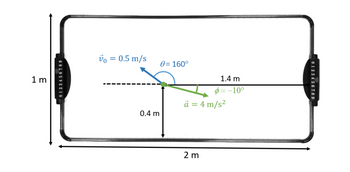
College Physics
11th Edition
ISBN: 9781305952300
Author: Raymond A. Serway, Chris Vuille
Publisher: Cengage Learning
expand_more
expand_more
format_list_bulleted
Question
An air hockey puck is initially moving at 0.5 m/s at an angle of 160° on a tilted table where the tilt imparts an acceleration to the puck of 4 m/s2 at an angle of -10° (or 350°) as shown below. When and where will the puck first hit one of the walls of the air hockey table?

Transcribed Image Text:1m
6849948810
Vo = 0.5 m/s
0.4 m
0= 160°
1.4 m
= -10°
à = 4 m/s²
2 m
0123456789
Expert Solution
This question has been solved!
Explore an expertly crafted, step-by-step solution for a thorough understanding of key concepts.
This is a popular solution
Trending nowThis is a popular solution!
Step by stepSolved in 3 steps with 4 images

Knowledge Booster
Learn more about
Need a deep-dive on the concept behind this application? Look no further. Learn more about this topic, physics and related others by exploring similar questions and additional content below.Similar questions
- If a rocket is shot and lands 200m away, how long was it in the air if the initial velocity was 33 m/s and the angle is 75?arrow_forwardA river is about 5.7 m wide. Suppose an athlete wants to jump “over the river” and leaps at an angle of 35o with respect to the horizontal. What is the minimal initial speed that would allow the athlete to clear the gap? How much time is the athlete in the air? (please include images to help me understand :))arrow_forwardWhat is the velocity and horizontal velocity of a ping pong ball if it travels a a distance of 1.2 m and the launcher is at a 45 degree anglearrow_forward
- Don't Use Chat GPT Will Upvotearrow_forwardYou're playing a cartoony racing video game, with a character on a motorcycle. You drive your character off a ledge at 15 m/s. The next ledge for the character's bike to land on is 25 m away (horizontally) and 12 m below. Assume the video game has realistic physics coded into it, except that acceleration due to gravity is only 8.0 m/s^2. a) will your character land on the next platform? b) whether they land or not, find their velocity (magnitude and direction) as they either land on or pass through the 12 m below position.arrow_forwardYoure in an airplane that flies horizontally with speed 940km/h (260m/s) when the engine falls off. Neglecting air resisitence, assume it takes 27 s for the engine to hit the ground. Part A: Find the height of the airplane. Part B:Find the horizontal distance that the aircraft engine falls Part C: If the airplane somehow continues to fly as if nothing had happened, what is the distance between the engine and the airplane at the moment the engine hits the ground?arrow_forward
- A soccer ball is kicked with an initial horizontal velocity of 18 m/s and an initial vertical velocity of 13 m/s. 1) What is the initial speed of the ball? 2) What is the initial angle ? of the ball with respect to the ground? 3) What is the maximum height the ball goes above the ground? 4) How far from where it was kicked will the ball land?arrow_forwardFind the ranges shown for the projectiles in the figure for an initial speed of 50 m/s at the given initial angles. Part A: What is the range, in meters, for the projectile with the angle of 15°? Part B: What is the range, in meters, for the projectile with the angle of 45°? Part C: What is the range, in meters, for the projectile with the angle of 75°?arrow_forwardYou’ll now apply the horizontal launch to a car accident example. In this scenario, a car driver named Joshua Horton says he was driving at the speed limit of 45 mph when he hit an icy patch and drove through a guard rail of the 15 m tall bridge, before landing 24 m from the base of the bridge. Tes1ng shows that driving through the guard rail lowers a car’s speed by 10 m/s. QUESTION 3: Given the distance that the car landed from the bridge, determine what speed Joshua was actually driving before leaving the bridge. Was he telling the truth or lying? Show your calcula1ons here.arrow_forward
arrow_back_ios
arrow_forward_ios
Recommended textbooks for you
 College PhysicsPhysicsISBN:9781305952300Author:Raymond A. Serway, Chris VuillePublisher:Cengage Learning
College PhysicsPhysicsISBN:9781305952300Author:Raymond A. Serway, Chris VuillePublisher:Cengage Learning University Physics (14th Edition)PhysicsISBN:9780133969290Author:Hugh D. Young, Roger A. FreedmanPublisher:PEARSON
University Physics (14th Edition)PhysicsISBN:9780133969290Author:Hugh D. Young, Roger A. FreedmanPublisher:PEARSON Introduction To Quantum MechanicsPhysicsISBN:9781107189638Author:Griffiths, David J., Schroeter, Darrell F.Publisher:Cambridge University Press
Introduction To Quantum MechanicsPhysicsISBN:9781107189638Author:Griffiths, David J., Schroeter, Darrell F.Publisher:Cambridge University Press Physics for Scientists and EngineersPhysicsISBN:9781337553278Author:Raymond A. Serway, John W. JewettPublisher:Cengage Learning
Physics for Scientists and EngineersPhysicsISBN:9781337553278Author:Raymond A. Serway, John W. JewettPublisher:Cengage Learning Lecture- Tutorials for Introductory AstronomyPhysicsISBN:9780321820464Author:Edward E. Prather, Tim P. Slater, Jeff P. Adams, Gina BrissendenPublisher:Addison-Wesley
Lecture- Tutorials for Introductory AstronomyPhysicsISBN:9780321820464Author:Edward E. Prather, Tim P. Slater, Jeff P. Adams, Gina BrissendenPublisher:Addison-Wesley College Physics: A Strategic Approach (4th Editio...PhysicsISBN:9780134609034Author:Randall D. Knight (Professor Emeritus), Brian Jones, Stuart FieldPublisher:PEARSON
College Physics: A Strategic Approach (4th Editio...PhysicsISBN:9780134609034Author:Randall D. Knight (Professor Emeritus), Brian Jones, Stuart FieldPublisher:PEARSON

College Physics
Physics
ISBN:9781305952300
Author:Raymond A. Serway, Chris Vuille
Publisher:Cengage Learning

University Physics (14th Edition)
Physics
ISBN:9780133969290
Author:Hugh D. Young, Roger A. Freedman
Publisher:PEARSON

Introduction To Quantum Mechanics
Physics
ISBN:9781107189638
Author:Griffiths, David J., Schroeter, Darrell F.
Publisher:Cambridge University Press

Physics for Scientists and Engineers
Physics
ISBN:9781337553278
Author:Raymond A. Serway, John W. Jewett
Publisher:Cengage Learning

Lecture- Tutorials for Introductory Astronomy
Physics
ISBN:9780321820464
Author:Edward E. Prather, Tim P. Slater, Jeff P. Adams, Gina Brissenden
Publisher:Addison-Wesley

College Physics: A Strategic Approach (4th Editio...
Physics
ISBN:9780134609034
Author:Randall D. Knight (Professor Emeritus), Brian Jones, Stuart Field
Publisher:PEARSON